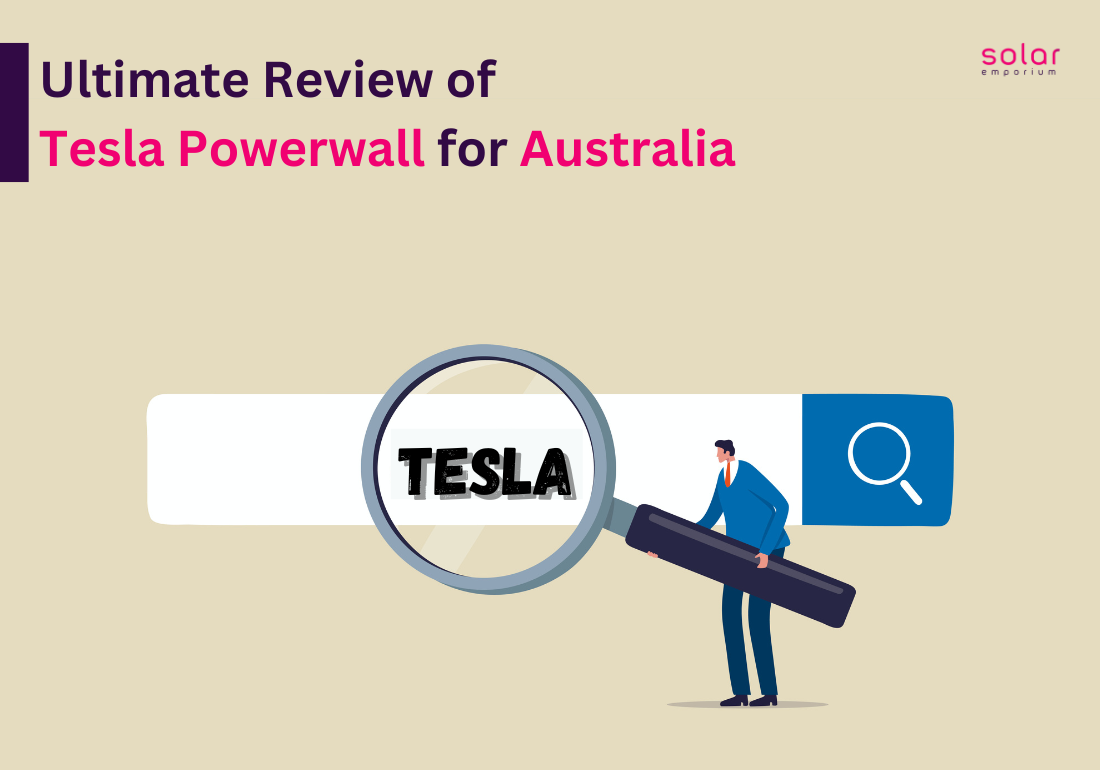As Australia continues to embrace renewable energy, homeowners are increasingly looking for ways to store and manage their solar power.
One of the most popular options on the market is the Tesla Powerwall. It is a home battery system storing solar energy during peak demand hours or power outages. And today, we’ll provide the ultimate review of Tesla Powerwall for Australia.
In this comprehensive review, we’ll explore the features, benefits, and drawbacks of the Tesla Powerwall for Australian consumers.
This ultimate review of Tesla Powerwall will help you decide if it’s the right choice for your home. We’ll also discuss optimising your solar energy storage to maximise your investment return.
Tesla Powerwall: An Overview
The Tesla Powerwall is a lithium-ion battery system that stores excess solar energy from your home’s solar panels. It allows you to use solar power during the evening or when the sun isn’t shining.
It will ultimately reduce your reliance on the grid and lower your electricity bills. The Powerwall can also provide backup power during outages, ensuring your home has power even during blackouts.
Key Features

- Capacity: The Tesla Powerwall has a usable capacity of 13.5 kWh, making it suitable for most average-sized Australian houses. The capacity allows you to store enough energy to power your home during peak demand hours or low solar generation.
- Scalability: If your energy needs are more significant than what a single Powerwall can provide, you can easily connect multiple units to increase your storage capacity.
- Efficiency: The Powerwall boasts a round-trip efficiency of 90%, meaning that for every 10 kWh of solar energy stored, you can expect to use 9 kWh. This high efficiency ensures minimal energy loss during the charging and discharging process.
- Backup Power: In a grid outage, the Powerwall can automatically switch to provide backup power for your home. That ensures you stay connected during blackouts.
- Smart Monitoring: The Tesla app allows you to monitor your Powerwall’s performance, solar generation, and energy usage in real-time. It gives you greater control over your home’s energy management.
Installation and Compatibility
The Tesla Powerwall is compatible with most solar panel systems and inverters, making it a versatile option for homeowners with existing solar installations.
The installation process typically takes one day and should be carried out by a certified Tesla installer to ensure optimal performance and safety.
Ultimate Cost of Tesla Powerwall and Savings

The cost of a Tesla Powerwall in Australia varies depending on factors such as installation fees and government incentives. You can pay around $12,000 to $15,000 for a single Powerwall, including installation.
The Tesla Powerwall 2 is the most popular for the average Australian house. It also costs around AUD 12,000 to AUD 15,000, including installation. Keep in mind that this price may change depending on your specific condition.
At the same time, this is a significant upfront investment. But the potential savings on your electricity bills can make it worthwhile in the long run.
Using stored solar energy during peak demand hours can avoid paying high electricity rates and reduce your reliance on the grid. Depending on your energy usage patterns and local electricity rates, you could save thousands of dollars over the lifetime of the Powerwall.
It’s essential to consider additional costs. Such as the cost of a compatible solar inverter if you still need one and any electrical work required for the installation. Also, check for any available government incentives or rebates that could help reduce the overall cost.
We recommend contacting Solar Emporium, a Tesla-certified installer, for the most accurate and up-to-date pricing. Or visit the Tesla website for more information.
Environmental Impact
Warranty and Lifespan
The Tesla Powerwall comes with a 10-year warranty covering any defects in quality or materials. The warranty guarantees a minimum of 70% capacity retention after 10 years, ensuring your Powerwall remains a valuable asset for your home’s energy management.
The lifespan of a Powerwall depends on factors such as usage patterns and environmental conditions. However, your Powerwall can last well beyond its warranty period with proper maintenance and care.
Maximising Solar Energy Storage and Return on Investment

- Optimize your solar panel system: Ensure your solar panels are installed correctly and well-maintained to maximise energy generation.
- Monitor your energy usage: Use the Tesla app to track your energy consumption and identify areas to reduce usage or shift usage to off-peak times.
- Take advantage of government incentives: Research available government incentives and rebates for solar energy storage systems to help offset the cost of your Powerwall.
- Consider time-of-use tariffs: If your electricity provider offers time-of-use tariffs, you can maximise your savings by using stored solar energy during peak pricing periods
What is the Payback Time for Tesla Powerwall In Australia?
The payback time for a Tesla Powerwall in Australia depends on several factors, including the cost of the Powerwall and installation, electricity rates, solar panel production, and any available government incentives or rebates.
Here’s a rough calculation to give you an idea of the payback period:
How Long Does the Tesla Powerwall Last When Fully Charged?
Tesla recently released a Powerwall battery that stores solar or wind energy. It promises to revolutionise energy storage and reduce energy bills for Australians. So how long will a Tesla Powerwall battery last when fully charged in Australia?
Tesla’s Powerwall uses advanced technologies like thermal management, protection circuitry, and active thermal management. It is expected to revolutionise how Australians use renewable energy and reduce energy bills.
The Powerwall battery has a capacity of 10kW-100kW and can store power generated from solar or wind power.
A Tesla Powerwall battery’s ability to provide power depends on the household’s energy consumption and the specific model of the Powerwall. In Australia, the Tesla Powerwall 2 is the most common model. It has a usable capacity of 13.5 kWh.
To determine how long a fully charged Powerwall will last, you’ll need to consider the household’s energy consumption. For example, if a home uses an average of 2 kWh per hour, the Powerwall 2 would last approximately 6.75 hours (13.5 kWh / 2 kWh = 6.75 hours).
Keep in mind that energy consumption can vary depending on factors such as the size of the home, the number of occupants, and the types of appliances being used.
Potential Drawbacks
- High upfront cost: The initial investment for a Powerwall can be significant, making it less accessible for some Australian homeowners.
- Availability: Due to high demand, there can sometimes be a waiting period for Powerwall installations in Australia.
Get Tesla Powerwall With Solar Emporium
The Tesla Powerwall is an innovative and efficient home battery system that offers numerous benefits for Australian homeowners. It includes energy savings, backup power, and a reduced carbon footprint.
While the upfront cost can be significant, the potential long-term savings and environmental benefits make it a worthwhile investment for many households. The initial cost can be decreased by monitoring your energy usage and using government incentives.
Solar Emporium’s lucrative solar packages and free quotes can instantly offer you reasonable prices.
Before deciding if the Tesla Powerwall suits your home, it’s essential to consider factors such as your energy usage patterns, solar panel system, and local electricity rates.
You should carefully weigh the benefits and drawbacks and implement strategies to maximise solar energy storage and return on investment. And then, you can decide whether the Tesla Powerwall is your home’s ultimate energy storage solution.
Tesla Powerwall is valuable in your journey toward a more sustainable, cost-effective energy future.
Frequently Asked Questions

Q: Can the Tesla Powerwall charge from the grid?
A: While the primary purpose of the Powerwall is to store solar energy, it can also be configured to charge from the grid during off-peak times when electricity rates are lower. This can benefit homeowners without solar panels or during periods of low solar generation.
Q: How long does it take for the Tesla Powerwall to pay for itself?
A: The payback period for a Tesla Powerwall depends on factors such as your energy usage patterns, solar panel system, local electricity rates, and government incentives. On average, homeowners expect a payback period of 7 to 12 years.
Q: Can the Tesla Powerwall power my entire home during a blackout?
A: The Powerwall can provide backup power during outages. The Powerwall’s ability to power your entire home during a blackout depends on its capacity and your home’s energy consumption.
It may not be able to power all appliances simultaneously. However, it can provide backup power for essential devices such as lights, refrigerators, and communication devices.
But the capacity may need to be increased to power your entire home for a long time. Prioritising necessary appliances and devices during a blackout is essential to maximise the Powerwall’s usefulness.
Q: Can I add a Tesla Powerwall to my solar panel system?
A: The Tesla Powerwall is compatible with most solar panel systems and inverters. A certified Tesla installer can assess your system and determine how to integrate the Powerwall best.

